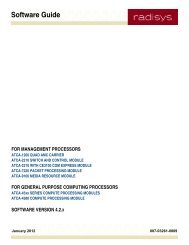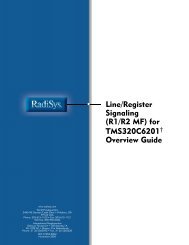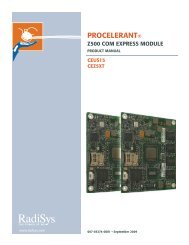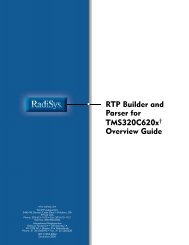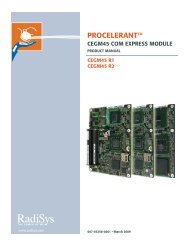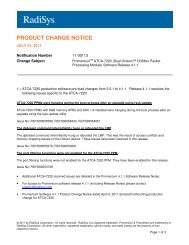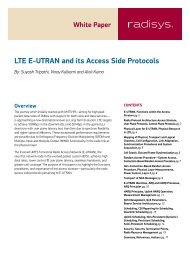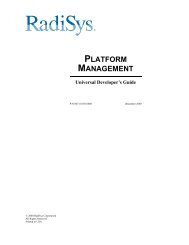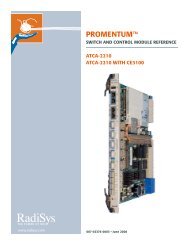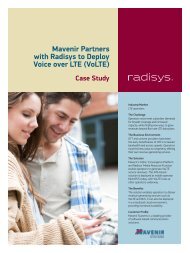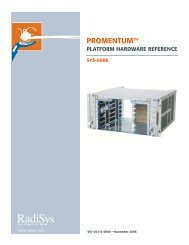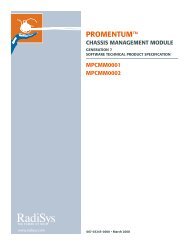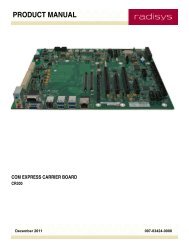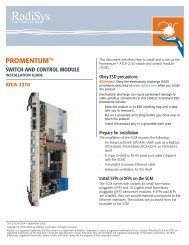ITU-T G.729 Speech Coder for TMS320C6201 Overview ... - Radisys
ITU-T G.729 Speech Coder for TMS320C6201 Overview ... - Radisys
ITU-T G.729 Speech Coder for TMS320C6201 Overview ... - Radisys
Create successful ePaper yourself
Turn your PDF publications into a flip-book with our unique Google optimized e-Paper software.
www.radisys.com<br />
World Headquarters<br />
5445 NE Dawson Creek Drive • Hillsboro, OR<br />
97124 USA<br />
Phone: 503-615-1100 • Fax: 503-615-1121<br />
Toll-Free: 800-950-0044<br />
International Headquarters<br />
Gebouw Flevopoort • Televisieweg 1A<br />
NL-1322 AC • Almere, The Netherlands<br />
Phone: 31 36 5365595 • Fax: 31 36 5365620<br />
007-00968-0002<br />
November 2000<br />
<strong>ITU</strong>-T <strong>G.729</strong><br />
<strong>Speech</strong> <strong>Coder</strong> <strong>for</strong><br />
<strong>TMS320C6201</strong> †<br />
<strong>Overview</strong> Guide
November 2000<br />
Copyright ©2000 by RadiSys Corporation.<br />
All rights reserved.<br />
EPC, iRMX, INtime, Inside Advantage, and RadiSys are registered trademarks of RadiSys Corporation. Spirit,<br />
DAI, DAQ, ASM, Brahma, and SAIB are trademarks of RadiSys Corporation.<br />
† All other trademarks, registered trademarks, service marks, and trade names are the property of their<br />
respective owners.
<strong>ITU</strong>-T <strong>G.729</strong> <strong>Speech</strong> <strong>Coder</strong> <strong>for</strong><br />
<strong>TMS320C6201</strong><br />
The <strong>ITU</strong>-T <strong>G.729</strong> <strong>Speech</strong> <strong>Coder</strong> <strong>for</strong> <strong>TMS320C6201</strong> algorithm, as specified by the<br />
<strong>ITU</strong>-T Recommendation <strong>G.729</strong> “Coding of speech at 8 kbits/s using conjugatestructure<br />
algebraic-code-excited linear-prediction (CS-ACELP)”, is optimally<br />
implemented <strong>for</strong> the Texas Instruments TMS320C6x digital signal processor.<br />
The <strong>Speech</strong> <strong>Coder</strong> is implemented as an encoder and decoder based on 10 ms<br />
frames, i.e., they act only upon data collected <strong>for</strong> 10 ms.<br />
For in<strong>for</strong>mation about installing and using the <strong>Speech</strong> <strong>Coder</strong> software, see the<br />
topics listed below.<br />
For in<strong>for</strong>mation about...<br />
Go to this page...<br />
Installation ........................................................................................................... 2<br />
Requirements ................................................................................................. 2<br />
Install the software ......................................................................................... 2<br />
Compile and link the software......................................................................... 3<br />
Application programmer interface......................................................................... 3<br />
Init_G729Encoder .......................................................................................... 4<br />
Init_G729Decoder .......................................................................................... 5<br />
G729Encoder ................................................................................................. 5<br />
G729_Decoder............................................................................................... 6<br />
G729Encoder1 ............................................................................................... 6<br />
G729Encoder2 ............................................................................................... 7<br />
G729_Decoder............................................................................................... 7<br />
Run-time initializations.................................................................................... 8<br />
Testing and per<strong>for</strong>mance specifications................................................................. 8<br />
Where to get more in<strong>for</strong>mation........................................................................... 10<br />
1
RadiSys Corporation<br />
Installation<br />
To make the <strong>Speech</strong> <strong>Coder</strong> software fully functional, follow these steps:<br />
Start<br />
Install the<br />
software<br />
Compile and link<br />
the software<br />
Requirements<br />
Install the software<br />
Done<br />
Figure 1. Installing and building the <strong>Speech</strong> <strong>Coder</strong> software<br />
Be<strong>for</strong>e you can install this software, you need the following:<br />
• A Microsoft † Windows † 95, Windows 98, or Windows NT † compatible<br />
PC plat<strong>for</strong>m.<br />
• The following software installed on your computer:<br />
• TMS320C6x Code Generation Tools Release 3.01 <strong>for</strong> Windows 95,<br />
Windows 98, or Windows NT<br />
—or—<br />
Code Composer Studio Tools, version 1.2, <strong>for</strong> Windows 95, Windows 98,<br />
or Windows NT.<br />
• NMAKE utility (available from Microsoft).<br />
• PKUNZIP utility.<br />
To install the <strong>Speech</strong> <strong>Coder</strong> software:<br />
1. Create a directory on the target system. For example:<br />
mkdir c:\g729<br />
2. Copy the product files from the CD-ROM to the directory you just created.<br />
Use a copy utility that retains the directory structure, such as Xcopy.<br />
2
<strong>ITU</strong>-T <strong>G.729</strong> <strong>Speech</strong> <strong>Coder</strong> <strong>for</strong> <strong>TMS320C6201</strong> <strong>Overview</strong> Guide<br />
Compile and link the software<br />
To compile and link the <strong>Speech</strong> <strong>Coder</strong> software:<br />
1. Open an MS DOS command prompt window and go to the target directory,<br />
then go to the /c6xsim sub-directory.<br />
2. If you’ve already installed the TI tools, you can build the c6x version of the<br />
<strong>Speech</strong> <strong>Coder</strong> by entering this command at the MS DOS command prompt:<br />
NMAKE -f g729bld.mak<br />
Code organization<br />
When installed, the <strong>Speech</strong> <strong>Coder</strong> software files reside in this directory structure:<br />
1 This file is tested to work with the Microsoft NMAKE utility, and can be modified to work with other<br />
make utilities.<br />
Application programmer interface<br />
The \testvecs sub-directory contains files that have input and output test<br />
vectors <strong>for</strong> each module. These files have extensions of .IN2, .IN, .BIT,<br />
or .PST.<br />
Directory Extension File type Description<br />
\g729 .pdf User’s manual Includes this guide, in PDF <strong>for</strong>mat.<br />
\g729\c6xsim<br />
Control source and executable <strong>for</strong> C6x<br />
.c C files (wrapper code) Control source files.<br />
.cmd Linker command files Linker command files control object<br />
modules, linking options, and<br />
memory maps. These files include:<br />
• coder.cmd: Command file <strong>for</strong> the<br />
G729 Encoder Module.<br />
• decoder.cmd: Command file <strong>for</strong><br />
the G729 Decoder Module.<br />
.lib Library files The g729.lib file is a library of all<br />
object modules.<br />
.mak Build file The g729bld.mak file 1 controls the<br />
build process.<br />
\g729\include .h Header files Header files used to build the <strong>Speech</strong><br />
<strong>Coder</strong>. Applications can share these<br />
files as well.<br />
\g729\testvecs Test vector files <strong>ITU</strong>-T test vectors.<br />
Once you’ve installed and built the <strong>Speech</strong> <strong>Coder</strong> software, you can use the <strong>Speech</strong><br />
<strong>Coder</strong> functions in your C application code.<br />
Observe the following while developing your applications:<br />
• All module execution shall be done on 10ms frames.<br />
3
RadiSys Corporation<br />
• Channel Variable, Control, Tables buffer allocation in the data memory are not<br />
part of the mentioned APIs.<br />
• G729 Encoder and Decoder assume that higher level control allocates the data<br />
memory based on the size of each structure and the alignment.<br />
The next section describes the APIs used <strong>for</strong> the functional implementation of<br />
<strong>ITU</strong>-T G729 coder. This section specifies the APIs <strong>for</strong> two different memory<br />
configurations:<br />
• Configuration 1: Runs the complete encoder from external memory as a<br />
single module.<br />
• Configuration 2: The G729 Encoder code is separated into two modules to fit<br />
into internal memory of the <strong>TMS320C6201</strong>.<br />
You must know the configuration be<strong>for</strong>e calling the APIs.<br />
APIs <strong>for</strong> initialization<br />
The application needs to call this API once at the start of the call. This needs to be<br />
done <strong>for</strong> every new call.<br />
Configuration 1 and Configuration 2<br />
Init_G729Encoder<br />
Syntax<br />
void Init_G729Encoder(<br />
g729EncVars *variables_buf,<br />
g729CodTabs *tables_buf<br />
);<br />
Parameters<br />
For structure definitions, see include\tab_ld8k.h <strong>for</strong> the <strong>G.729</strong> coder. And <strong>for</strong><br />
execution sequence of all APIs, see c6xsim\coder.c <strong>for</strong> G729 encoder and<br />
c6xsim\decoder.c <strong>for</strong> decoder in the directory.<br />
variables_buf<br />
Pointer to Channel Encoder State Variable structure with sizeof<br />
(g729EncVars), 32-bit alignment, and persistent (2268 bytes).<br />
tables_buf<br />
Pointer to Global Tables structure with sizeof(g729CodTabs), 32-bit<br />
alignment, and shared (7460 bytes).<br />
4
<strong>ITU</strong>-T <strong>G.729</strong> <strong>Speech</strong> <strong>Coder</strong> <strong>for</strong> <strong>TMS320C6201</strong> <strong>Overview</strong> Guide<br />
Init_G729Decoder<br />
Syntax<br />
Configuration 1<br />
G729Encoder<br />
void Init_G729Decoder(<br />
g729DecVars *variables_buf,<br />
g729CodTabs *tables_buf<br />
);<br />
Parameters<br />
variables_buf<br />
Pointer to Channel Decoder State Variable structure with sizeof<br />
(g729DecVars), 32-bit alignment, and persistent (1376 bytes).<br />
tables_buf<br />
Pointer to Global Tables structure with sizeof(g729CodTabs), 32-bit<br />
alignment, and shared (7460 bytes).<br />
APIs <strong>for</strong> run-time execution<br />
The application needs to call this API <strong>for</strong> every 10ms frame after the start of call<br />
and initialization.<br />
Syntax<br />
void G729Encoder(<br />
g729EncVars *variables_buf,<br />
g729CodTabs *tables_buf,<br />
short *pInBuf,<br />
unsigned char *pNwOutBuf,<br />
unsigned char nb_words<br />
);<br />
Parameters<br />
variables_buf<br />
Pointer to Channel Encoder State Variable structure with sizeof<br />
(g729EncVars), 32-bit alignment, and persistent (2268 bytes).<br />
tables_buf<br />
Pointer to Global Tables structure with sizeof(g729CodTabs), 32-bit<br />
alignment, and shared (7460 bytes).<br />
pInBuf<br />
pNwOutBuf<br />
Short Pointer to received PCM data, 32-bit alignment, non-persistent<br />
(160 bytes).<br />
Unsigned Char Pointer to the compressed data to be transmitted, 8-bit<br />
alignment, non-persistent (10 bytes).<br />
5
RadiSys Corporation<br />
nb_words<br />
Number of valid bytes in the compressed packet (pNwOutBuf), 8-bit<br />
alignment, non-persistent (1 byte).<br />
G729_Decoder<br />
Syntax<br />
void G729_Decoder(<br />
g729DecVars *variables_buf,<br />
g729CodTabs *tables_buf,<br />
unsigned char *pNwInBuf,<br />
unsigned char Status,<br />
Word16 *pOutBuf<br />
)<br />
Parameters<br />
variables_buf<br />
Pointer to Channel Decoder State Variable structure with sizeof<br />
(g729DecVars), 32-bit alignment, and persistent (1376 bytes).<br />
tables_buf<br />
Pointer to Global Tables structure with sizeof(g729CodTabs), 32-bit<br />
alignment, and shared (7460 bytes).<br />
pNwInBuf<br />
Status<br />
pOutBuf<br />
Configuration 2<br />
G729Encoder1<br />
Syntax<br />
Unsigned Char Pointer to received data from network, 8-bit alignment,<br />
non-persistent (10 bytes).<br />
Unsigned Char status of the compressed packet received from the<br />
network, 8-bit alignment, non-persistent (1 byte).<br />
Short Pointer to PCM data to be transmitted, 32-bit alignment,<br />
non-persistent (160 bytes).<br />
void G729Encoder1(<br />
short *pInBuf,<br />
g729EncVars *variables_buf,<br />
g729CodTabs *tables_buf<br />
)<br />
Parameters<br />
variables_buf<br />
Pointer to Channel Encoder State Variable structure with sizeof<br />
(g729EncVars), 32-bit alignment, and persistent (2268 bytes).<br />
tables_buf<br />
Pointer to Global Tables structure with sizeof(g729CodTabs), 32-bit<br />
alignment, and shared (7460 bytes).<br />
6
<strong>ITU</strong>-T <strong>G.729</strong> <strong>Speech</strong> <strong>Coder</strong> <strong>for</strong> <strong>TMS320C6201</strong> <strong>Overview</strong> Guide<br />
pInBuf<br />
Short Pointer to received PCM data, 32-bit alignment, non-persistent<br />
(160 bytes).<br />
G729Encoder2<br />
Syntax<br />
G729_Decoder<br />
void G729Encoder2(<br />
g729EncVars *variables_buf,<br />
g729CodTabs *tables_buf,<br />
unsigned char *pNwOutBuf,<br />
unsigned char *nb_words<br />
)<br />
Parameters<br />
variables_buf<br />
Pointer to Channel Encoder State Variable structure with sizeof<br />
(g729EncVars), 32-bit alignment, and persistent (2268 bytes).<br />
tables_buf<br />
Pointer to Global Tables structure with sizeof(g729CodTabs), 32-bit<br />
alignment, and shared (7460 bytes).<br />
pNwOutBuf<br />
nb_words<br />
Syntax<br />
Unsigned Char Pointer to the compressed data to be transmitted, 8-bit<br />
alignment, non-persistent (10 bytes).<br />
Number of valid bytes in the compressed packet (pNwOutBuf), 8-bit<br />
alignment, non-persistent (1 byte).<br />
void G729_Decoder(<br />
g729DecVars *variables_buf,<br />
g729CodTabs *tables_buf,<br />
unsigned char *pNwInBuf,<br />
unsigned char Status,<br />
Word16 *pOutBuf<br />
)<br />
Parameters<br />
variables_buf<br />
Pointer to Channel Decoder State Variable structure with sizeof<br />
(g729DecVars), 32-bit alignment, and persistent (1376 bytes).<br />
tables_buf<br />
Pointer to Global Tables structure with sizeof(g729CodTabs), 32-bit<br />
alignment, and shared (7460 bytes).<br />
pNwInBuf<br />
Unsigned Char Pointer to received data from network, 8-bit alignment,<br />
non-persistent (10 bytes).<br />
7
RadiSys Corporation<br />
Status<br />
pOutBuf<br />
Unsigned Char status of the compressed packet received from the<br />
network, 8-bit alignment, non-persistent (1 byte).<br />
Short Pointer to PCM data to be transmitted, 32-bit alignment,<br />
non-persistent (160 bytes).<br />
Run-time initializations<br />
pInBuf Short Pointer to the TDM Input buffer (16-bit PCM samples) size of 160<br />
bytes, 32 bit alignment.<br />
pOutBuf<br />
pNwInBuf<br />
pNwOutBuf<br />
Short Pointer to the TDM Output buffer (16-bit PCM samples) size of<br />
160 bytes, 32 bit alignment.<br />
Unsigned Char Pointer to received network packet data, 8-bit alignment,<br />
and non-persistent (10 bytes).<br />
Unsigned Char Pointer to network packet data to be transmitted, 8-bit<br />
alignment, and non-persistent (10 bytes).<br />
Status (8-bit)<br />
Application need to provide the status in<strong>for</strong>mation based on the network<br />
packets/data.<br />
If(PacketSize==10)<br />
Status = ACTIVE_FRAME;<br />
Else<br />
Status = G729BAD_FRAME;<br />
Testing and per<strong>for</strong>mance specifications<br />
Test procedure<br />
The <strong>G.729</strong> software is tested using the Texas Instruments XDS-510 JTAG emulator<br />
on the TEB (Test Evaluation Board) from Texas Instruments. The TEB used in these<br />
tests had Rev. 1.5 of the <strong>TMS320C6201</strong> on it. The emulator software version used<br />
in the test procedure did not allow command line arguments <strong>for</strong> file names, hence<br />
the file names <strong>for</strong> the input and output vectors were hard-coded as shown in the<br />
following module description tables.<br />
For this test the code is assumed to be resident in c:\g729\c6xsim and test vectors in<br />
c:\g729\testvecs.<br />
Encoder test procedure<br />
1. Copy c:\g729\testvecs\algthm.in c:\g729\c6xsim\coder.in<br />
2. Run coder.out using Texas Instruments emulator to produce the file decoder.in<br />
8
<strong>ITU</strong>-T <strong>G.729</strong> <strong>Speech</strong> <strong>Coder</strong> <strong>for</strong> <strong>TMS320C6201</strong> <strong>Overview</strong> Guide<br />
Decoder.in is the serial bit output file which should be same as the <strong>ITU</strong>-T test<br />
vector file c:\g729\testvecs\algthm.bit<br />
Table 1. Encoder module test summary<br />
Module name<br />
Input Vector File Names<br />
Input Vector <strong>for</strong>mat<br />
Typical <strong>ITU</strong> file from <strong>G.729</strong><br />
test vectors<br />
Output Vector File Name<br />
Output Vector <strong>for</strong>mat<br />
<strong>Coder</strong>.out<br />
<strong>Coder</strong>.in<br />
<strong>Coder</strong>.in: 16 bit binary voice samples, Intel<br />
Algthm.in<br />
decoder.in<br />
<strong>ITU</strong>-T Serial Bit Frame <strong>for</strong>mat. Each frame consists of<br />
80 short words<br />
Decoder test procedure<br />
1. Copy c:\g729\testvecs\algthm.bit to c:\g729\c6xsim\decoder.in<br />
2. Run decoder.out using TI emulator to produce the file decoder.res<br />
3. decoder.res is the serial bit output file which should be same as the <strong>ITU</strong>-T test<br />
vector file c:\g729\testvecs\algthm.pst<br />
Table 2. Decoder module test summary<br />
Module name<br />
Input Vector File Names<br />
Input Vector <strong>for</strong>mat<br />
Typical <strong>ITU</strong>-T file from<br />
<strong>G.729</strong> test vectors<br />
Output Vector File Name<br />
Output Vector <strong>for</strong>mat<br />
<strong>Coder</strong>.out<br />
Decoder.in<br />
<strong>ITU</strong>-T Serial Bit Vector Frame Format. Each frame<br />
consist of 82 short words (164 bytes).<br />
Algthm.bit<br />
decoder.res<br />
16-bit binary voice samples, Intel.<br />
Per<strong>for</strong>mance specification<br />
The per<strong>for</strong>mance results were computed <strong>for</strong> the test vector in the file algthm.in,<br />
with Texas Instruments Code Composer Studio Tools, version 1.2. The cycle count<br />
is <strong>for</strong> the module API functions excludes bit-packing, file reading and writing cycles,<br />
and with all C files compiled with -o2 optimizer option.<br />
Module<br />
Cycles<br />
(speech)<br />
Table 3. <strong>G.729</strong> c6x code per<strong>for</strong>mance<br />
MCPS – speech<br />
(assuming 200<br />
MHz DSP)<br />
Program<br />
memory<br />
(Kbytes)<br />
Data memory<br />
(Kbytes) tables,<br />
var.<br />
Stack<br />
(Kbytes)<br />
Encoder 108000 10.8 51.5 7.46 2.26 3.25<br />
Decoder 28000 2.8 26.4 7.46 1.37 1.5<br />
9
RadiSys Corporation<br />
Where to get more in<strong>for</strong>mation<br />
About the <strong>ITU</strong>-T <strong>G.729</strong> <strong>Speech</strong> <strong>Coder</strong> <strong>for</strong> <strong>TMS320C6201</strong><br />
You can find out more about the <strong>Speech</strong> <strong>Coder</strong> from these sources:<br />
• Readme file: Lists features and issues that arose too late to include in other<br />
documentation.<br />
• World Wide Web: RadiSys maintains an active site on the World Wide Web. The<br />
site contains current in<strong>for</strong>mation about the company and locations of sales<br />
offices, new and existing products, contacts <strong>for</strong> sales, service, and technical<br />
support in<strong>for</strong>mation. You can also send e-mail to RadiSys using the web site.<br />
About related products<br />
Requests <strong>for</strong> sales, service, and technical support in<strong>for</strong>mation receive<br />
prompt response.<br />
SP6040<br />
The RadiSys SP6040 (SPIRIT-6040 CompactPCI † board) is a high-per<strong>for</strong>mance<br />
intelligent I/O subsystem designed <strong>for</strong> telecom and datacom applications. Based on<br />
Texas Instruments † devices, the SP6040 has a 200MHz DSP engine with an I/O<br />
connector that provides interface-to-digital network interfaces (DNI) such as E1/T1<br />
and ATM. The SP6040 contains up to four <strong>TMS320C6201</strong> digital signal processors.<br />
SP6020<br />
The RadiSys SP6020 (SPIRIT-6020 board) features two Texas Instruments<br />
<strong>TMS320C6201</strong>B fixed-point DSPs that run at 200MHz and serve as the main<br />
processing engines. Each ’C6x can deliver up to 1600 MIPS of processing power,<br />
contingent on the available parallelism within the application code. The DSPs are<br />
used <strong>for</strong> voice and data processing, compression, and decompression.<br />
TASK-6000<br />
When sending e-mail <strong>for</strong> technical support, please include in<strong>for</strong>mation<br />
about both the hardware and software, plus a detailed description of the<br />
problem, including how to reproduce it.<br />
To access the RadiSys web site, enter this URL in your web browser:<br />
http://www.radisys.com<br />
TASK-6000 software is a tool set that provides a framework <strong>for</strong> composing,<br />
executing and dynamically configuring optimized real-time TMS320C62x DSP<br />
applications. The Voice Gateway Plat<strong>for</strong>m (VGP), available from RadiSys, is used<br />
as the reference hardware plat<strong>for</strong>m.<br />
10
<strong>ITU</strong>-T <strong>G.729</strong> <strong>Speech</strong> <strong>Coder</strong> <strong>for</strong> <strong>TMS320C6201</strong> <strong>Overview</strong> Guide<br />
For detailed in<strong>for</strong>mation about TASK-6000 products, see the following<br />
publications:<br />
TASK-6000 User’s Manual, (07-0992-xx)<br />
TASK-6000 Installation Guide, (07-1000-xx)<br />
TI tools<br />
Software tools from Texas Instruments used to build DSP executables.<br />
For more in<strong>for</strong>mation about Texas Instruments products, enter this URL in<br />
your web browser:<br />
http://www.ti.com/dsp<br />
11
RadiSys Corporation<br />
12



